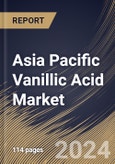In the Vanillic Acid market, a purity level of 99% represents a premium grade product sought after for its exceptional quality and reliability. With a purity of 99%, Vanillic Acid meets stringent standards, ensuring consistency and effectiveness in various applications across industries such as food and beverage, pharmaceuticals, and cosmetics. Therefore, the China market would consume 1,106.5 tonnes of 99% pure Vanillic Acid by 2031.
The China market dominated the Asia Pacific Vanillic Acid Market by Country in 2023, and would continue to be a dominant market till 2031; thereby, achieving a market value of $2,555.5 million by 2031. The Japan market is exhibiting a CAGR of 2.1% during (2024 - 2031). Additionally, The India market would experience a CAGR of 2.9% during (2024 - 2031).
There is growing interest in functional foods and nutraceuticals that offer health benefits beyond basic nutrition. It is known for its antioxidant, anti-inflammatory, and antimicrobial properties, is gaining attention as a functional ingredient in dietary supplements, functional beverages, and fortified food products. It targets various health concerns such as inflammation, oxidative stress, and digestive health.
In addition, the market is witnessing growth and expansion, driven by increasing demand from emerging economies, technological advancements, and shifting consumer preferences. Manufacturers are exploring new market opportunities, expanding distribution networks, and forging strategic partnerships to capitalize on the growing demand for vanillic acid.
South Korea is renowned for its innovative and cutting-edge cosmetic formulations, often referred to as K-beauty or Korean beauty products. As South Korean cosmetic companies continue introducing novel skincare, makeup, and hair care products, there is a growing demand for unique and effective ingredients like vanillic acid to differentiate their formulations and cater to consumer preferences. As per the data from the International Trade Administration, for 2021, the total value of cosmetics produced in South Korea was $14.5 billion, and cosmetics exports hit a record high, growing 21.3 percent from the previous year to $9.2 billion. South Korea’s trade surplus in the cosmetics sector grew by 28.6 percent to $7.8 billion. Therefore, the expansion of the pharmaceutical industry and the rising cosmetics industry in the region is propelling the market’s growth.
Based on Purity, the market is segmented into Purity 98%, Purity 99%, and Others. Based on Application, the market is segmented into Flavors & Fragrances, Pharmaceutical Intermediates, and Others. Based on countries, the market is segmented into China, Japan, India, South Korea, Singapore, Malaysia, and Rest of Asia Pacific.
List of Key Companies Profiled
- Solvay SA
- Lanxess AG
- Parchem Fine and Specialty Chemicals, Inc.
- Biosynth AG (Carbosynth Ltd.)
- Cayman Chemical Company, Inc.
- Merck Millipore (Merck Group)
- Tokyo Chemical Industry Co., Ltd.
- Otto Chemie Pvt. Ltd.
- Santa Cruz Biotechnology, Inc.
- Spectrum Chemical Mfg. Corp.
Market Report Segmentation
By Purity (Volume, Tonnes, USD Billion, 2020-2031)- Purity 98%
- Purity 99%
- Others
- Flavors & Fragrances
- Pharmaceutical Intermediates
- Others
- China
- Japan
- India
- South Korea
- Singapore
- Malaysia
- Rest of Asia Pacific
Table of Contents
Companies Mentioned
- Solvay SA
- Lanxess AG
- Parchem Fine and Specialty Chemicals, Inc.
- Biosynth AG (Carbosynth Ltd.)
- Cayman Chemical Company, Inc.
- Merck Millipore (Merck Group)
- Tokyo Chemical Industry Co., Ltd.
- Otto Chemie Pvt. Ltd.
- Santa Cruz Biotechnology, Inc.
- Spectrum Chemical Mfg. Corp.
Methodology

LOADING...









